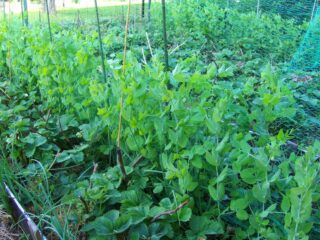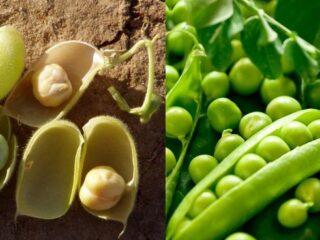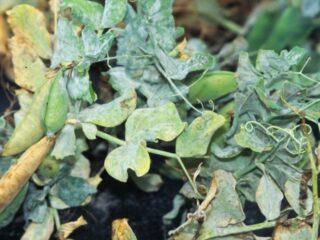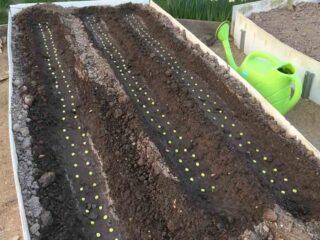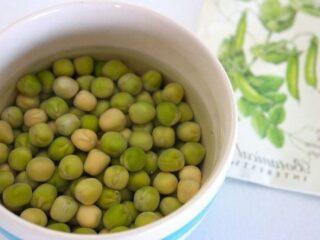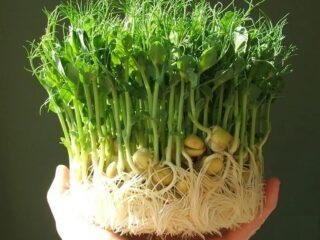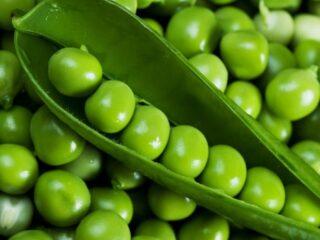Content
- 1 Types of peas
- 2 The best varieties of peas with photos and descriptions
- 3 Zoned pea varieties
- 4 Conclusion
There are dozens of pea varieties - there are large, small, low-growing and tall types. Before choosing seeds for planting, you need to carefully study the existing variety.
Types of peas
Peas are classified according to several criteria - by the shape of the pods and beans, by the timing of ripening and purpose. Some varieties are well suited for fresh consumption, others are used for preservation.
According to the structure of the bean
Based on the structure of the bean with seeds, peas are divided into two types:
- Peeling. The inside of the valves of this variety is covered with a hard parchment layer. They are not suitable for food consumption and must be thrown away.
- Sugar. The bean leaves are soft, without a parchment layer, have a sweet taste and are suitable for use in food.
Sugar varieties are often used fresh in salads along with the outer shell.
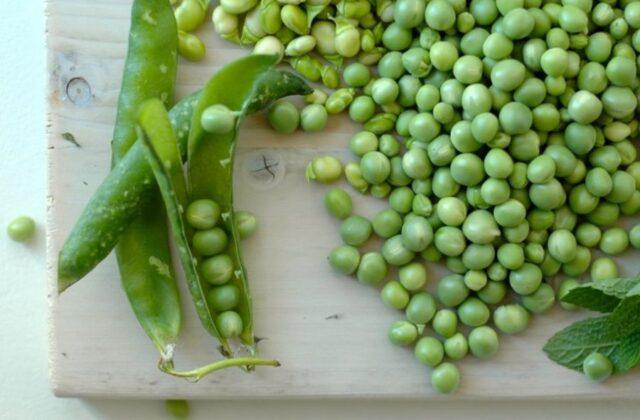
Shelling peas are used mainly for boiling and canning.
By purpose
Sowing peas are divided into three types according to their intended purpose:
- canning - the seeds are used in their unripe form for storing for the winter;
- table - ripe grains are added to cold and hot dishes;
- universal - the fruits are equally often consumed both fresh and dry.
According to the shape of the grains
Based on the shape of the seeds, peas are divided into two types:
- regular - with smooth rounded grains;
- medullary - seeds are angular and wrinkled after drying.
In fresh form, ordinary varieties are often used. Brain mushrooms are used for boiling and preservation because they do not crumble due to their low starch content.
According to ripening time
When choosing a type of crop, you need to think about the time frame in which you would like to receive the harvest. Pea varieties are:
- early - seeds ripen in 1.5-2 months;
- medium - 2-2.6 months pass before harvest;
- late - seeds can ripen up to three months.
The best varieties of peas with photos and descriptions
Garden crops are very popular among breeders.There are dozens of universal and regionalized varieties of peas with photos and names.
Shelling pea varieties
Peeling varieties, in comparison with sugar varieties, are distinguished by greater shelf life. They are worth planting if pea seeds are to be stored for the winter for long-term storage.
Dakota
Dakota shelling peas mature in 55 days and bear long pods containing eight green seeds each. The height of the plant is about 65 cm. The species tolerates unfavorable weather well and produces stable yields.
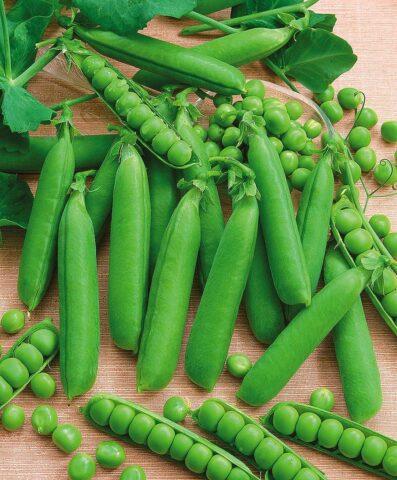
Dakota rarely suffers from powdery mildew and fusarium
Fork
The tuning fork rises up to 120 cm above the ground and produces hard, long pods with light green beans. It does not lie down and does not fall off, although it requires garter, and ripens in the middle period. Well suited for growing in difficult climatic conditions.
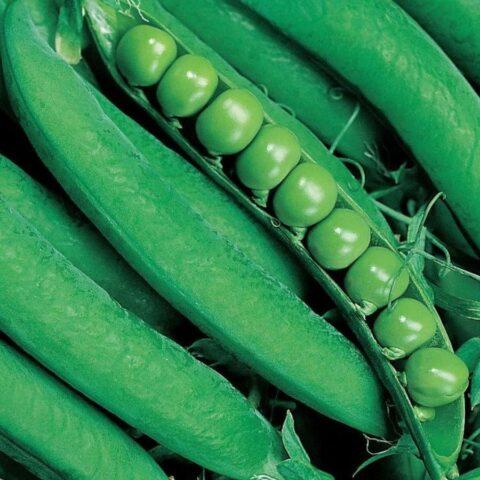
Tuning fork contains a lot of protein in ripe peas
Adagumsky
The mid-season variety produces round, dark green beans with pointed tips. It rises up to 75 cm above the ground; a support for the variety does not need to be installed. Each pod contains eight medium-sized grains.
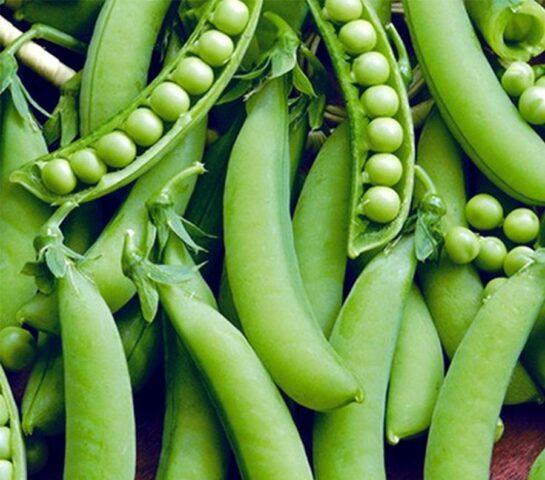
The Adagumsky variety ripens in 68 days
Brain pea varieties
Delicious brain peas are especially sweet. It is grown mainly for boiling and preservation.
Harp
A tasty variety of peas ripens in an average of 57 days. Gives good yields up to 700 g per square meter. The pods contain two beans and up to nine seeds in long axils. The fruits have a pleasant sweet taste and good juiciness.
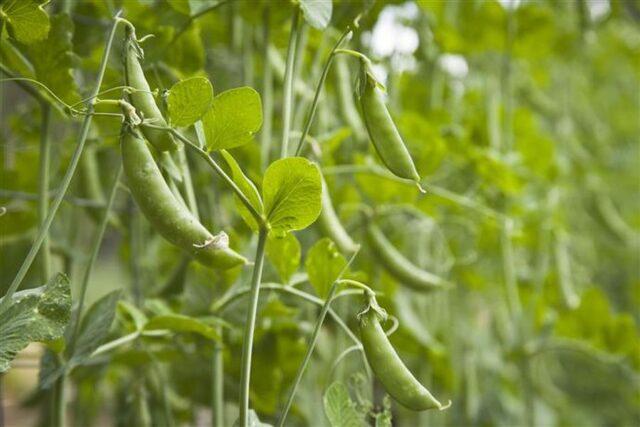
The Harp species rarely suffers from fusarium and ascochyta blight.
Monogram
A low variety up to 70 cm produces straight beans with pointed tops, with dense and juicy green peas located inside. It takes about 60 days from germination to ripening. The variety is rarely affected by fungal diseases and is characterized by high productivity.
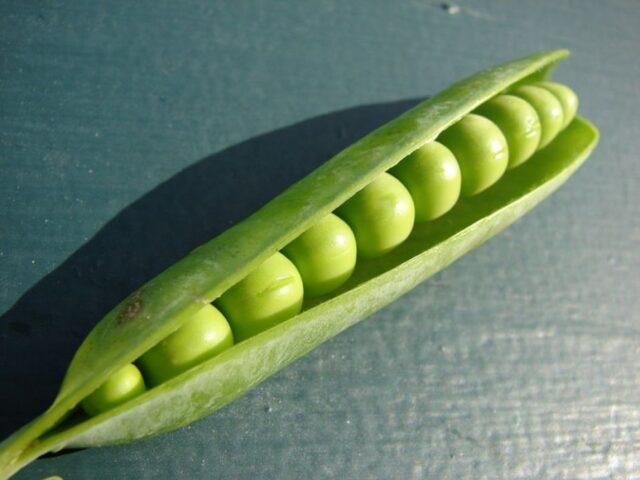
Wenzel peas are used in side dishes and soups
Voronezh green
Early peas begin to bear fruit 45 days after sprouts emerge from the soil. The seeds of the variety are large, up to 1 cm in diameter, and bright green in color. They have excellent nutritional qualities and are used fresh and in preparations.
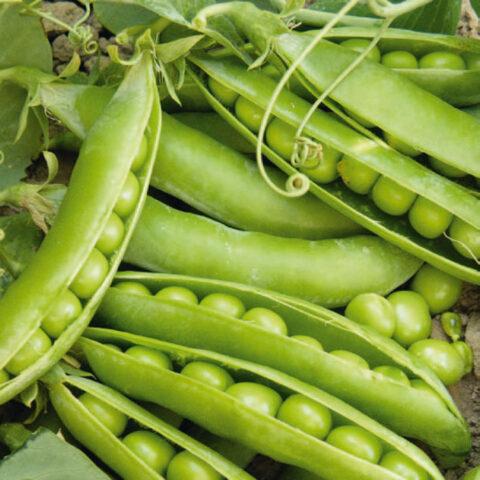
Voronezh green peas grow up to 1 m
The sweetest (sugar) pea varieties
Sweet peas are popular due to the fact that they are suitable for food consumption whole, including the leaves. It has a delicious taste and is especially often used in salads and preserves.
Baby sugar
Delicious sweet peas feature long, slightly curved pods with dense, round fruit. There is no parchment layer in the pods, so the whole variety can be eaten. The yield is 2.5 kg per meter of planting.
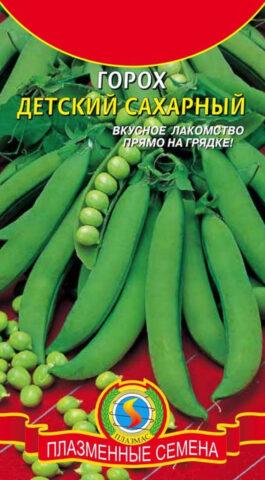
Children's sugar ripens within 1.5-2 months
honey pod
Short, medium-ripening peas bear fruit approximately 55 days after germination. The beans are sweet, small, with wrinkled seeds, the lower pods are located 40 cm above the ground.
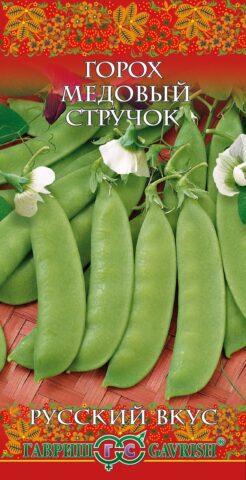
The Honey Pod variety produces modest but stable yields
Sugar girlfriend
The medium-sized variety produces up to 1.3 kg of fruit per square meter; the pods are long with a pointed top. There is no hard layer inside, the seeds are tender in taste and sweet. The bottom beans are 70 cm above the ground.
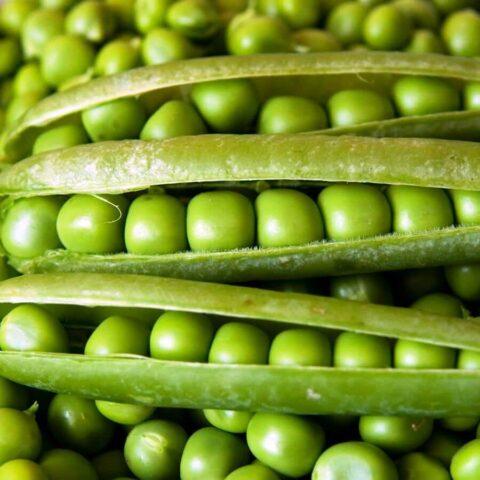
Sugar peas ripen in 65 days
Low-growing pea varieties that do not require support
Growing crops in a summer cottage is complicated by the fact that most species require the installation of trellises. However, there are varieties of peas that do not need to be tied up; they do not rise high above the ground and do not lie down even during the fruiting period.
Grandma's surprise
A peeling variety with germination 1.5 months after sprouting produces up to 500 g of seeds per meter of garden. The fruits are sweet and large, the beans are slightly curved and have a hard layer inside. The variety grows up to 65 cm in height.
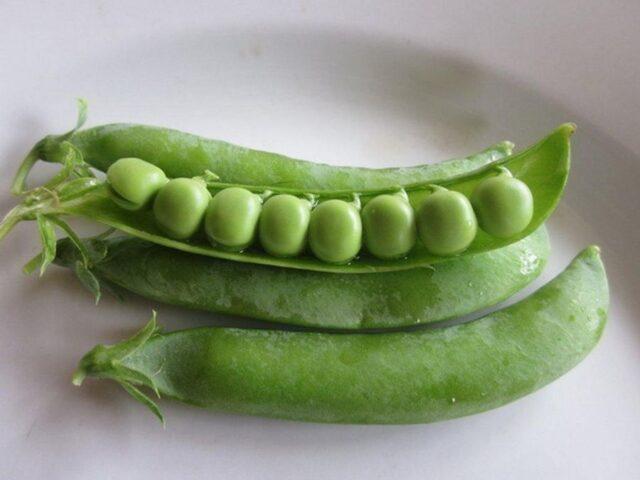
Babushkin Surprise peas tolerate cold well and are suitable for northern regions
Vatan
A hardy variety of upright peas up to 75 cm tall produces abundant harvests of medium-sized beans with yellowish round seeds. It does not crumble and rarely suffers from diseases and pests. It has modified leaves that look like tendrils.
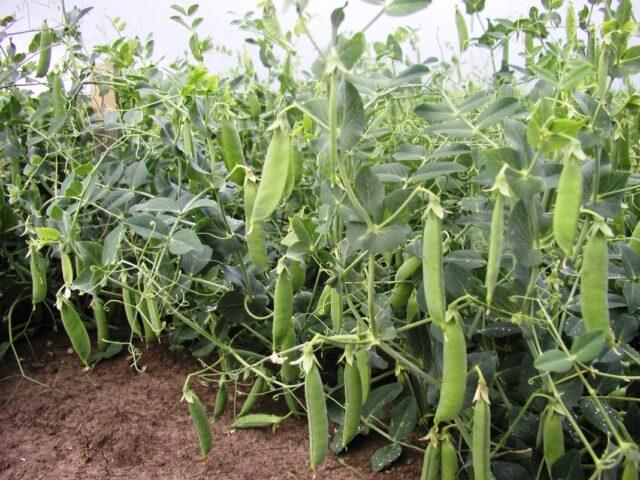
Variety Vatan ripens within 70 days
Slider
The leafless species Slider grows up to 70 cm and produces narrow, green fruits with large grains. It does not require support and does not lie down; it is characterized by unpretentiousness. The disadvantage of the variety is considered to be a long growing season of up to 7.5 weeks.
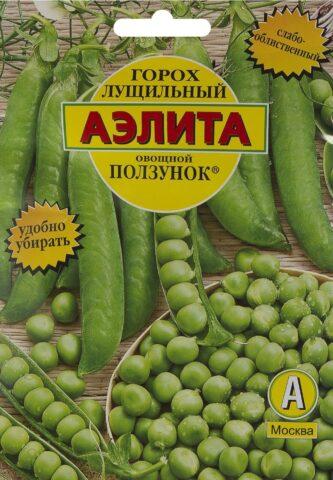
The Slider variety has a sweet taste and juiciness.
Tall pea varieties
Tall varieties of the crop require mandatory garter and careful care. But their advantages include greater productivity.
Telephone
The Telefon variety bears harvest approximately 100 days after sowing, with the lower beans ripening first and then the upper beans. The stem can stretch up to 2-3 m, and the length of the fruit exceeds 10 cm. The peas of the variety are large and spherical.
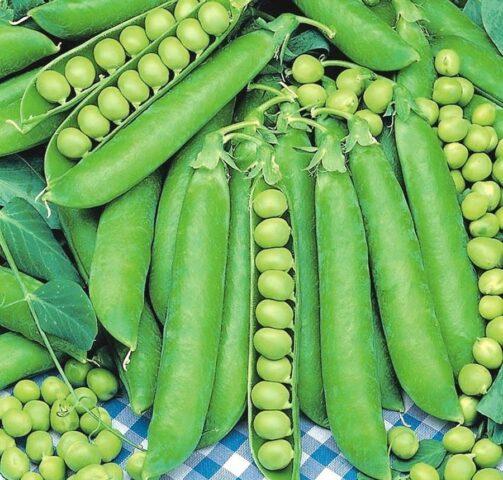
After harvesting the lower pods, the Telefon variety can form new beans
Zhegalova 112
The sugar variety with technical ripeness 60 days after emergence produces stable and voluminous yields. Pea beans are light green, straight up to 15 cm, the stem reaches 1.8 m in height.
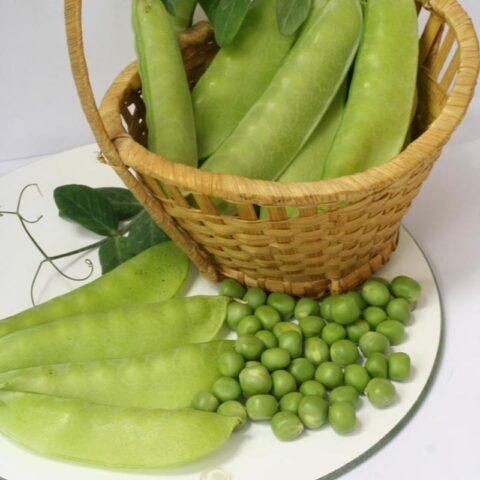
Zhegalov 112 peas are one of the oldest - they have been grown in Russia since 1943
Russian giant
A tall variety of peas up to 1.7 m above the ground produces dense long beans with fleshy walls. It is considered dietary, contains a lot of protein and sugar. When grown, it requires support and brings up to 1.4 kg of yield per meter of garden.
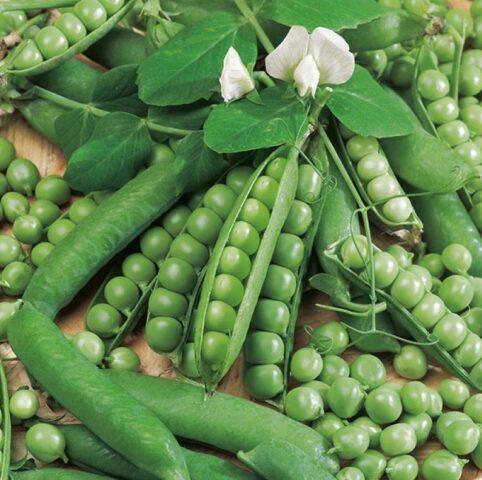
The Russian giant matures in 1.5 months
Large varieties of peas
Varieties with large seeds are particularly juicy. When caring for such varieties, you need to pay attention to watering - with a lack of moisture, the beans become smaller.
Prelado
A peeling pea variety that ripens within 90 days produces large pods up to 10 cm. It withstands hot weather well, but requires regular watering. Resistant to fungal diseases, characterized by increased sweetness and productivity.
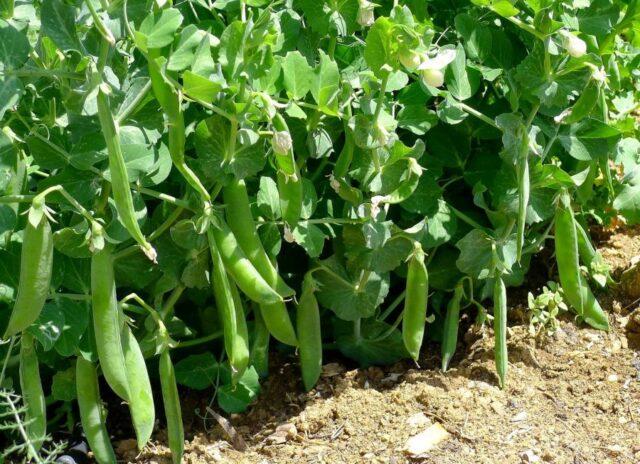
Prelado pea stem grows up to 65 cm
Gribovsky 11
Early shelling peas have been known in cultivation since 1964. The stem of the variety is short, up to 40 cm, the beans are straight or slightly curved, dark green, up to 10 cm in length. You can eat pea fruits canned or fresh.
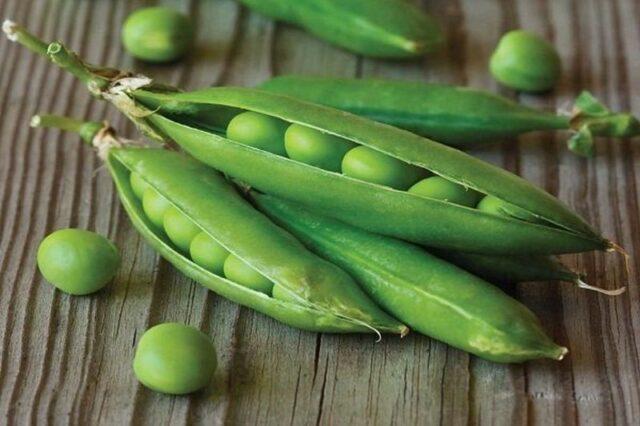
Gribovsky 11 ripens in 54 days
Russian size F1
The variety produces peas up to 1 cm in diameter with a sweet and delicate dessert taste. It has good frost resistance and is suitable for sowing in the ground in early spring. It develops quickly and needs support and quality watering.Reacts positively to fertilizing with phosphorus and potassium.
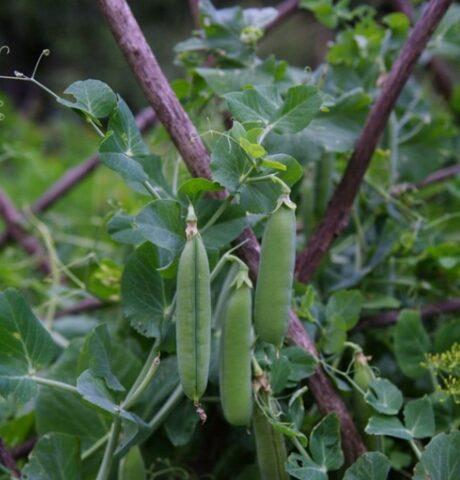
Peas Russian size stretches up to 90 cm
Early varieties of peas for open ground
Early ripening species allow you to get a harvest within 1.5 months after germination. These varieties are not inferior in taste to late varieties and are distinguished by good juiciness and sweetness.
Aria
One of the ultra-early varieties ripens in 52 days and produces straight beans with 6-9 peas in one pod. It is characterized by increased demands on watering, but it tolerates cold weather well and does not freeze when planted in the spring.
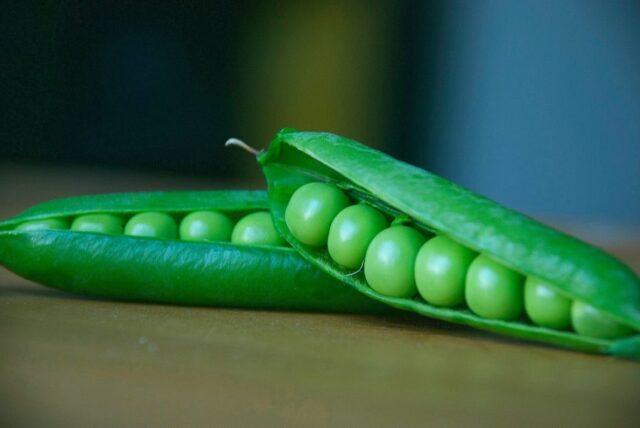
The Aria species is recommended for cultivation in the southern regions
Virtush
The early variety reaches maturity in an average of 47 days and produces juicy and sweet fruits. The disadvantages include unstable yields. From a meter of planting you can collect 300-600 g of seeds, depending on the weather and growing conditions.
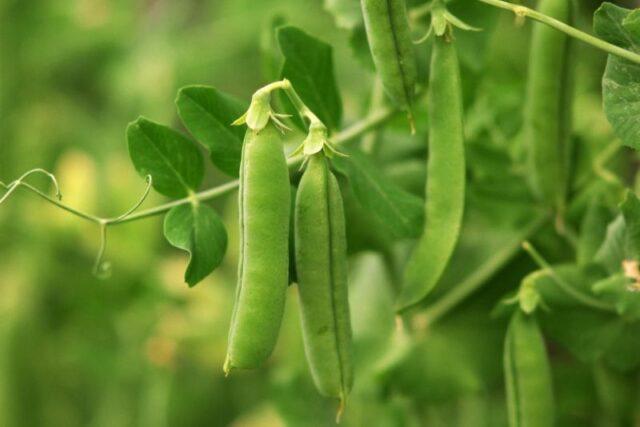
Virtush species is resistant to fusarium
Handsome
The early variety ripens in about 50 days, but cannot please with stability; harvests can be both large and very meager. Pea beans are long, with 5-7 peas, the taste is pleasant or dessert, depending on the conditions.
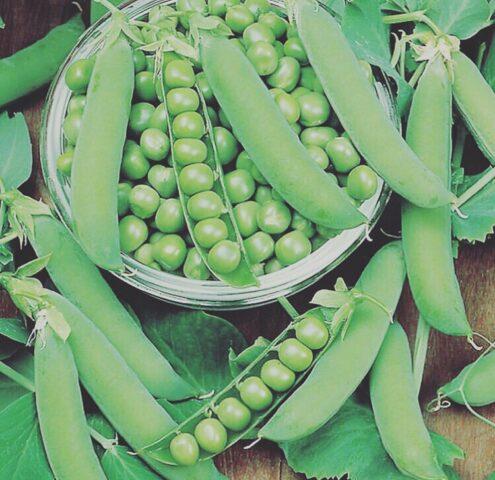
Handsome pea seeds ripen at the same time
High-yielding pea varieties
High-yielding species are of particular interest to those who grow crops on a large scale for sale. When choosing a variety, you need to look not only at the volume of fruiting, but also at the regularity.
Oscar
The mid-season variety ripens within 65 days and produces curved pods up to 12 cm. It rarely suffers from fungi, although it can be affected by fusarium. The average yield is about 900 g per square meter, but with good seed care there can be more.
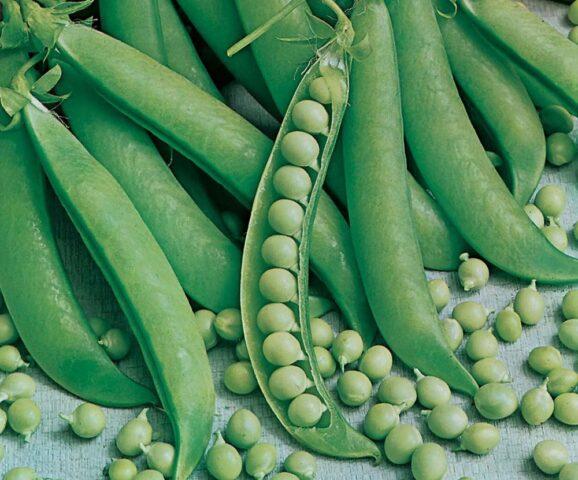
Oscar reaches 80 cm in height and needs to be tied up
Alpha
A productive pea variety up to 55 cm in height has a good sweet taste and is suitable for salads and long-term storage. Recommended for cultivation in Altai and Kamchatka, it produces up to 2.8 kg of fruit per meter of garden with high-quality care. The ripening of the pods is simultaneous.
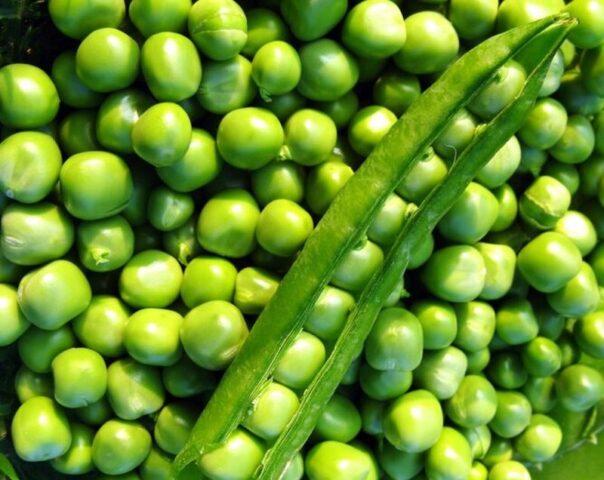
Alpha peas reach ripeness in an average of 53 days
The Miracle of Kelvedon
Sugar pea variety with large dark green pods tolerates cold well and does not die during cultivation. The fruits are large and high in protein. The plant branches weakly and stretches up to 55 cm.
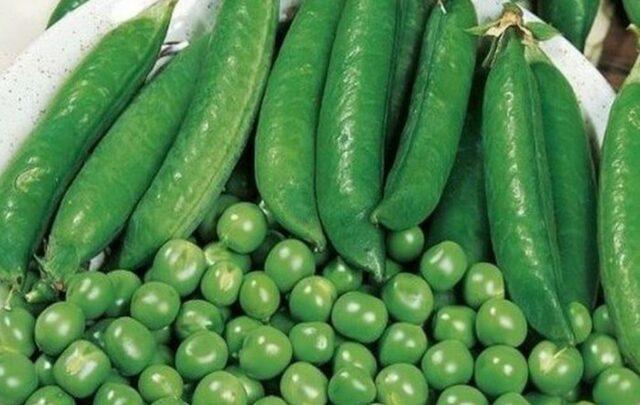
The ripening of the Miracle Kelvedon variety takes up to 75 days
Zoned pea varieties
When choosing a variety, you need to pay attention to the degree of its endurance and climate requirements. Peas, which can grow in the middle zone, do not always take root well in the northern regions.
The best pea varieties for Siberia
In Siberian conditions, medium-sized varieties with high cold resistance develop and bear fruit best. Peas should also be able to withstand lack of moisture and summer heat.
Varangian
The variety, zoned for Western Siberia and Altai, reaches 1 m in height and requires garter. It does not crumble or lie down in drought conditions, but may suffer from ascochyta blight. Reaches maturity in 80 days, bears ovoid smooth seeds, 4-7 in one pod.
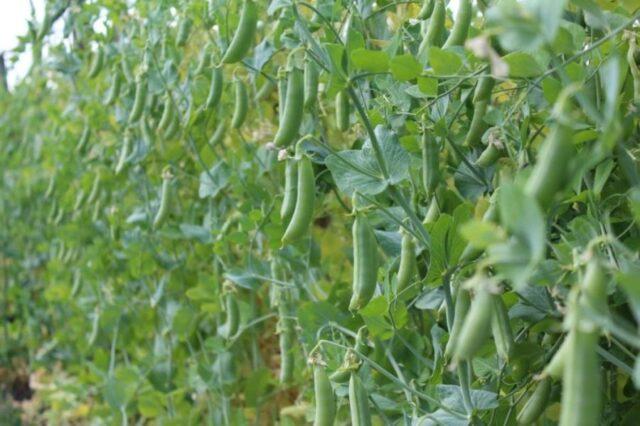
Varyag peas contain up to 30% protein
Yakhont
The mustachioed pea variety with straight pods and round seeds can develop in Western and Eastern Siberia. It has average yields and ripens in approximately 100 days. It tolerates drought well and does not fall off.
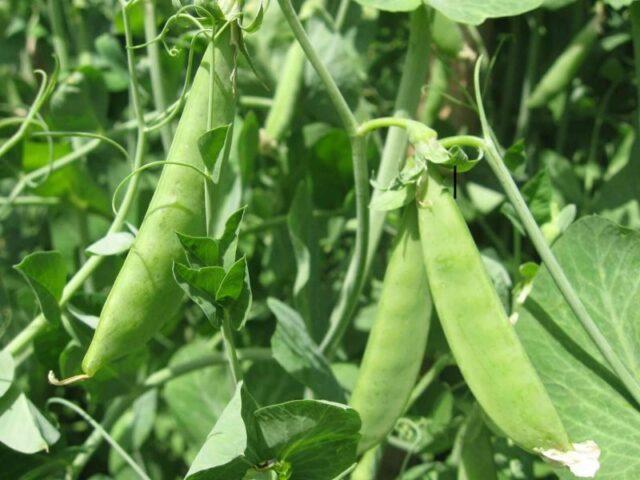
Variety Yakhont grows up to 1 m
Kemchug
Frost-resistant peas for Eastern Siberia and the Krasnoyarsk Territory are resistant to lodging, do not fall off and rarely suffer from drought. Produces slightly curved pods with spherical seeds. Ripens in an average period of about three months.
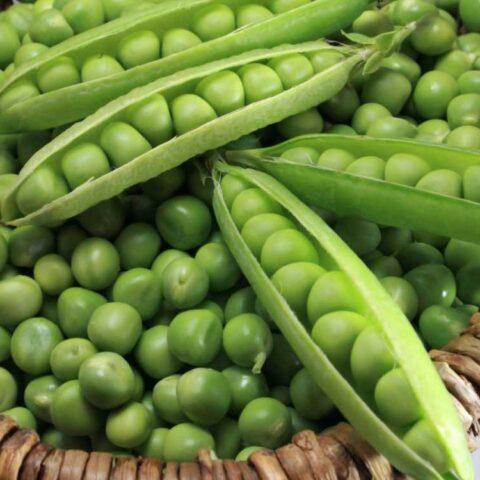
The Kemchug variety reaches 104 cm above the ground
The best pea varieties for the Leningrad region
In the Leningrad region, varieties with resistance to cold, lack of sunlight and wet soils develop well. In order for the crop to produce abundant harvests, you need to pay attention to fertilizing and regularly check the plantings for the presence of fungal infections.
Ambrosia
The variety becomes suitable for harvesting 50 days after germination. The pods are large, the beans are juicy and sweet, suitable for salads, snacks and preparations. A meter of planting in good conditions produces up to 600 g of fruit.
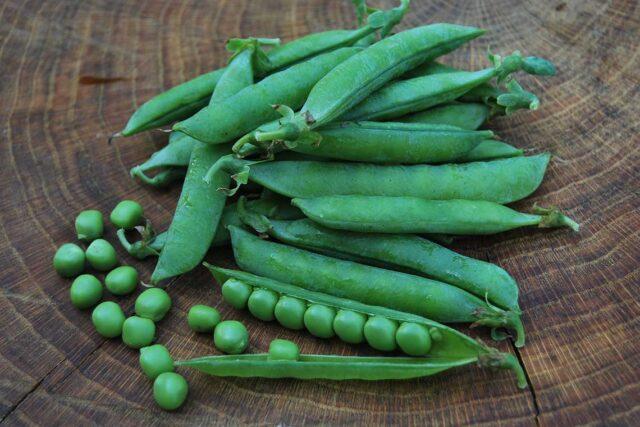
The Ambrosia variety rises up to 70 cm and requires support
Maisky 13
Vegetable peas with straight pods and rounded seeds develop over 60 days. It rarely suffers from fungi and tolerates night frosts well; beans ripen simultaneously.
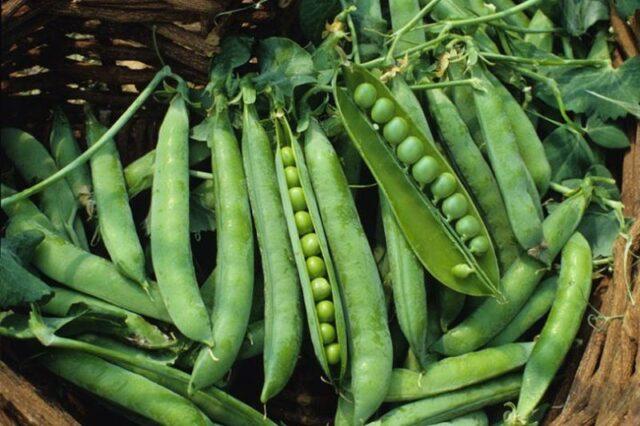
May 13 peas need a garter or supports, as they can lie down on the ground
Henry
The pea variety for planting in the Leningrad region allows you to harvest the first harvest on average 40 days after germination. It ripens unevenly, so the pods are picked in several stages. The variety's beans are light, up to 8 cm long.
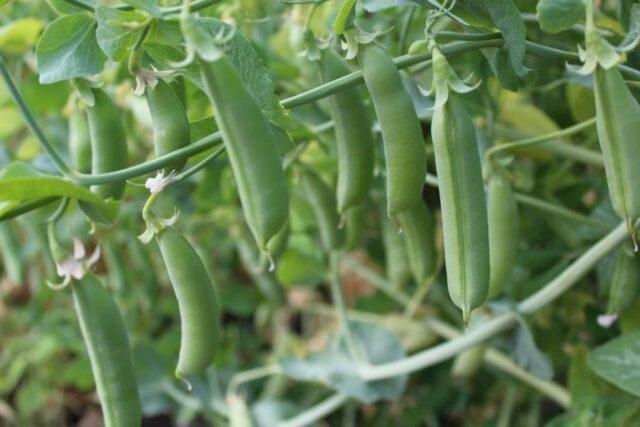
The Henry pea variety can be harvested already at the stage of technical maturity
Pea varieties for the Moscow region
In the Moscow region, almost all varieties develop well, with the exception of the most heat-loving ones. Cold-resistant species that do not suffer from late spring frosts are especially recommended for planting.
Gloriosa
Shelling peas up to 70 cm tall with saber-shaped pointed beans develop in approximately 55 days to technical ripeness. It has a sweet, juicy taste and rarely suffers from fusarium and ascochyta blight. The ripening of the pods is uniform, the yield rate is up to 1.5 kg per meter of soil.
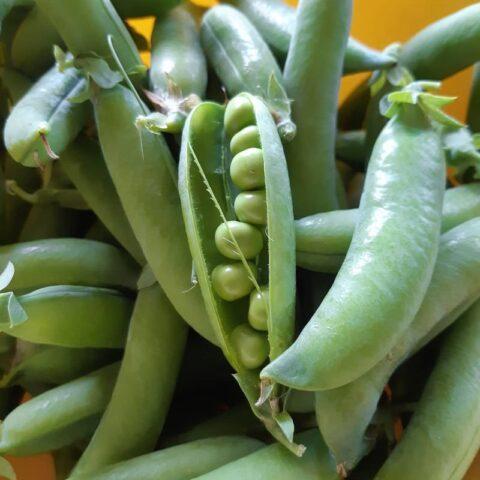
Gloriosa pea prefers sunny areas of the garden
Children's joy
A medium-branched bush pea variety up to 60 cm tall with dark green large fruits bears fruit abundantly and simultaneously. Suitable for freezing and canning, as well as for adding to salads immediately after collection. It has good nutritional value and contains a lot of protein.
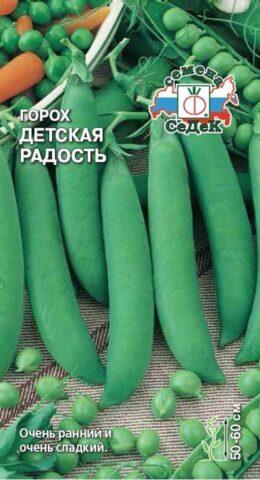
You can harvest Children's Joy peas two months after germination
Arrogant
The variety is zoned for the Central region and the Moscow region. The ripening period is early, the stem is medium in length up to 70 cm, the pods are straight and dark in color. The fruits have a pleasant taste, the seeds are brain-type, green in color.

Lower beans of the Zaznayka variety ripen 40 cm from the ground
Conclusion
Pea varieties are presented in a large number of options. From the existing diversity, you can choose species for the northern and southern regions of the country, for early and late harvesting. Most varieties do not require complex care and develop well with regular watering.
